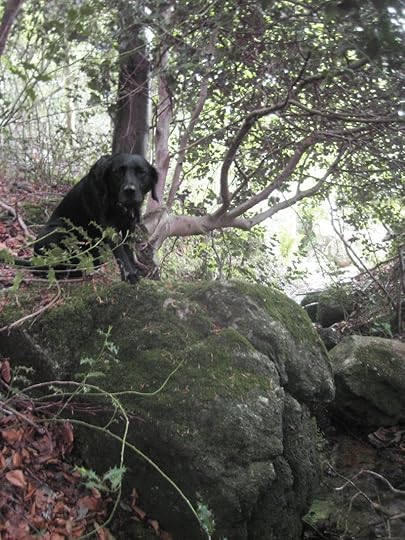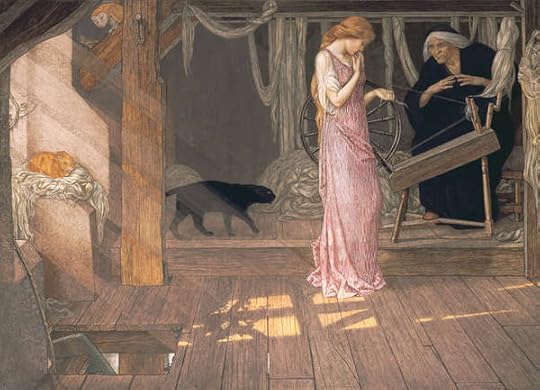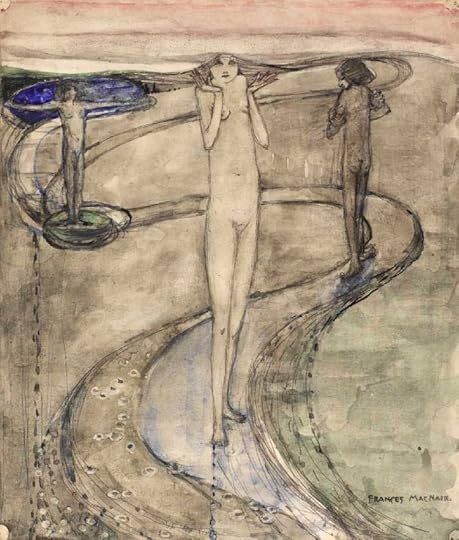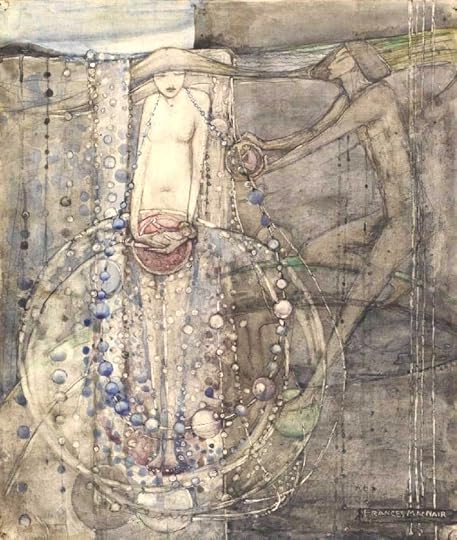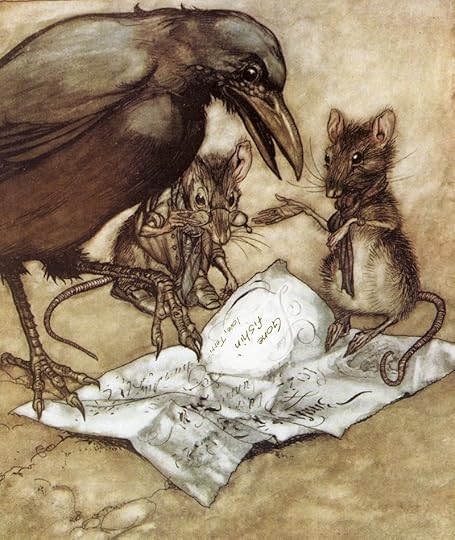Terri Windling's Blog, page 216
July 15, 2012
Tunes for a Monday Morning
Today's tunes are from First Aid Kit: Swedish sisters Klara and Johanna Söderberg, who sing like angels. (Their songwriting skills aren't too shabby either.)
Above: "When I Grow Up," with a fabulous animation by Rachael Greenfield.
Below: An atmospheric video for "The Lion's Roar."
If you'd to listen to a couple more songs this morning, try "Waltz for Richard," filmed in an alley in Melbourne, Australia, and "Emmylou," performed on Swedish tv. You'll find an interview with Klara and Johanna here, in Rookie Magazine.
July 14, 2012
Recommended Reading

A few quick recommendations today:
* Thedora Goss has posted some interesting thoughts "Selchie Women" on her writing blog.
"It occurred to me that there have always been selkie women," Dora writes, "women who did not seem to belong to this world, because they did not fit into prevailing notions of what women were supposed to be. And if you did not fit into those notions, in some sense you weren’t a woman. Weren’t even quite human. The magical animal woman is, or can be, a metaphor for those sorts of women."
* George Monbiot has published a fascinating article on "John Clare, poet of the environmental crisis 200 years ago" in The Guardian.
"His father was a casual farm labourer," writes Monbiot, "his family never more than a few days' wages from the poorhouse. Clare himself, from early childhood, scraped a living in the fields. He was schooled capriciously, and only until the age of 12, but from his first bare contact fell wildly in love with the written word. His early poems are remarkable not only for the way in which everything he sees flares into life, but also for his ability to pour his mingled thoughts and observations on to the page as they occur, allowing you, as perhaps no other poet has done, to watch the world from inside his head. Read The Nightingale's Nest, one of the finest poems in the English language, and you will see what I mean."
* Carlo Rotella discusses "The Art of Storytelling" in The European, coming at the subject from the point of view of a nonfiction writer and academic.
"I’m allergic to abstraction," Rotella says. "Especially in my first two books, I was telling the story of the transformation of urban America, especially in the so-called 'rust belt,' and of the decline of the industrial city and the rise of post-industrialism. But I could only tell it as a series of locally inflected stories about particular characters at particular moments in particular landscapes. They are almost always creative characters: Writers, or musicians. These characters are often filled with some urge, and I am basically writing the biography of that urge. How does the urge to play the guitar find expression in certain styles, which are attached to certain institutions, and then to the city?"
* Michael Cunningham has published a fascinating "Letter from the Pulitzer Fiction Jury: What Really Happened This Year" in The New Yorker. (It turns out that the jurors were as surprised as everyone else when no book won the prize this year.)
"Utter objectivity...is not only impossible when judging literature, it’s not exactly desirable," he notes. "Fiction involves trace elements of magic; it works for reasons we can explain and also for reasons we can’t. If novels or short-story collections could be weighed strictly in terms of their components (fully developed characters, check; original voice, check; solidly crafted structure, check; serious theme, check) they might satisfy, but they would fail to enchant. A great work of fiction involves a certain frisson that occurs when its various components cohere and then ignite."
So true.
* Also, it's good to see my old JoMA partner Midori Snyder back to regular blogging at In the Labyrinth (with its beautiful new page design). Particularly as she's the person who got me into blogging in the first place....
Image above: An illustration for Shakespeare's The Tempest by Edmund Dulac (1882-1953)
Recommendations

Some quick recommendations today:
* Thedora Goss has posted some interesting thoughts "Selchie Women" on her writing blog.
"It occurred to me that there have always been selkie women," Dora writes, "women who did not seem to belong to this world, because they did not fit into prevailing notions of what women were supposed to be. And if you did not fit into those notions, in some sense you weren’t a woman. Weren’t even quite human. The magical animal woman is, or can be, a metaphor for those sorts of women."
* George Monbiot has published a fascinating article on "John Clare, poet of the environmental crisis 200 years ago" in The Guardian.
"His father was a casual farm labourer," writes Monbiot, "his family never more than a few days' wages from the poorhouse. Clare himself, from early childhood, scraped a living in the fields. He was schooled capriciously, and only until the age of 12, but from his first bare contact fell wildly in love with the written word. His early poems are remarkable not only for the way in which everything he sees flares into life, but also for his ability to pour his mingled thoughts and observations on to the page as they occur, allowing you, as perhaps no other poet has done, to watch the world from inside his head. Read The Nightingale's Nest, one of the finest poems in the English language, and you will see what I mean."
* Carlo Rotella discusses "The Art of Storytelling" in The European, coming at the subject from the point of view of a nonfiction writer and academic.
"I’m allergic to abstraction," Rotella says. "Especially in my first two books, I was telling the story of the transformation of urban America, especially in the so-called 'rust belt,' and of the decline of the industrial city and the rise of post-industrialism. But I could only tell it as a series of locally inflected stories about particular characters at particular moments in particular landscapes. They are almost always creative characters: Writers, or musicians. These characters are often filled with some urge, and I am basically writing the biography of that urge. How does the urge to play the guitar find expression in certain styles, which are attached to certain institutions, and then to the city?"
* Also, it's good to see my old JoMA partner Midori Snyder back to regular blogging at In the Labyrinth (with its beautiful new page design). Particularly as she's the person who got me into blogging in the first place....
Image above: An illustration for Shakespeare's The Tempest by Edmund Dulac (1882-1953)
July 12, 2012
The truth of myth
“The job of a storyteller is to speak the truth. But what we feel most deeply can’t be spoken in words alone. At this level, only images connect. And here, story becomes symbol; symbol is myth. And myth is truth.” -- Alan Garner
“The best teachers have showed me that things have to be done bit by bit. Nothing that means anything happens quickly--we only think it does. The motion of drawing back a bow and sending an arrow straight into a target takes only a split second, but it is a skill many years in the making. So it is with a life, anyone's life. I may list things that might be described as my accomplishments in these few pages, but they are only shadows of the larger truth, fragments separated from the whole cycle of becoming. And if I can tell an old-time story now about a man who is walking about, waudjoset ndatlokugan, a forest lodge man, alesakamigwi udlagwedewugan, it is because I spent many years walking about myself, listening to voices that came not just from the people but from animals and trees and stones.” - Joseph Bruchac
"One of the things a writer is for is to say the unsayable, speak the unspeakable and ask difficult questions." - Salman Rushdie
"The job of the artist is always to deepen the mystery." - Frances Bacon
July 11, 2012
Following the muse
This is insanely beautiful: the mythic art of Jeanie Tomanek paired with the music of Estonian composer Arvo Pärt. I think it might be physically impossible to watch this and not feel inspired and uplifted....
"Great art is as irrational as great music," wrote the American drama critic George Jean Nathan. "It is mad with its own loveliness."
Indeed.
 "Capturing the Moon" by Jeanie Tomanek.
"Capturing the Moon" by Jeanie Tomanek.
Jeanie's enchanting website is here; and you'll find an article on her work and her long journey into the arts here, in the JoMA archives. ""I paint to explore the significance of ideas, memories, events, feelings, dreams and images that seem to demand my closer attention," she says. "Some of the themes I investigate emerge first in the poems I write. Literature, folktales, and myths often inspire my exploration of the feminine archetype. My figures often bear the scars and imperfections, that, to me, characterize the struggle to become."
She uses oils, acrylic, pencil and thin glazes to create "a multi–layered surface that may be scratched through, written on, or painted over to reveal and excavate the images that feel right for the work. In reclaiming and reconstructing areas of the canvas, the process of painting becomes analogous to having a second chance at your life, this time a little closer to the heart’s desire."
July 10, 2012
Made true by the telling
He unpacks his bag of tales
with fingers quick
as a weaver's
picking the weft threads
threading the warp.
Watch his fingers.
Watch his lips
speaking the old familiar words:
"Once there was
and there was not,
oh, best beloved,
when the world was filled with wishes
the way the sea is filled with fishes..."
All those threads
pulling us back
to another world, another time,
when goosegirls married well
and frogs could rhyme,
when maids spoke syllables of pearl
and stepmothers came to grief.
Belief is the warp
and the sharp-picked pattern
of motif
reminds us that Araby
is not so far;
that the pleasure dome
of a Bagdad caliph
sits side by side
with the rush-roofed home
of a Tattercoat or an animal bride.
Cinderella wears a shoe
first fitted in the East
where her prince -
no more a beast
than the usual run of royal son -
measures her nobility
by the lotus foot,
so many inches to the reign.
Then the slipper made glass
by a slip of ear and tongue.
All tales are mistakes
made true by the telling.
The watching eye takes in the hue,
the listening ear the word,
but all they comprehend is Art.
A story must be worn again
before the magic garment
fits the heart.
The storyteller is done.
He packs his bag.
But watch his fingers
and his lips.
It is the oldest feat
of prestidigitation.
What you saw,
what you heard
was equal to a new Creation.
The colors blur,
time is now.
He speaks his final piece
before his final bow:
"It is all true,
it is not true.
The more I tell you,
the more I shall lie.
What is a story
but jesting Pilate's cry.
I am not paid to tell you the truth."
_____________________________________________________________________
Images above: Sleeping Beauty illustration by John D. Batten (1860-1932), and four fairy tale illustrations by Arthur Rackham (1867-1939). "The Storyteller" is copyright c 1984 by Jane Yolen, and appears here with her permission. The poem was first published in National Storytelling Journal (1984), and reprinted in Jane's recent collection The Last Selchie Child (A Midsummer Night's Press, 2011).
Tell all the Truth, but tell it slant
"Fiction writers, at least in their braver moments, do desire the truth; to know it, speak it, serve it. But they go about it in a peculiar and devious way, which consists in inventing persons, places and events which never did and never will exist or occur, and telling about these fictions in detail and at length and with a great deal of emotion, and then when they are done writing down these pack of lies, they say, There! That's the truth!
"They may use all kinds of facts to support their tissues of lies. They may describe the Marshalsea Prison, which was a real place, or the battle of Borodino, which was really fought, or the process of cloning, which really takes place in laboratories, or the deterioration of personality, which is described in real textbooks of psychology; and so on. This weight of verifiable place-event-phenomenon-behavior makes readers forget they are reading pure invention, a history that never took place anywhere but in that unlocalized region, the author's mind. In fact, while we read a novel, we are insane -- bonkers. We believe in the existence of people who aren't there, we hear their voices, we watch the battle of Borodino with them, we may even become Napoleon. Sanity returns (in most cases) when the book is closed.
"Is it any wonder that no truly respectable society has ever trusted its artists?"
- Ursula K. Le Guin (The Language of the Night)
"Fiction is Truth's eldest sister. Obviously! No one in the world knew what truth was till someone had told a story." - Rudyard Kipling (A Book of Words)
Lord,
let me be brave. And let me, while I craft my tales, be wise.
Let me say true things in a voice that's true,
and, with the truth in mind, let me write lies.
- Neil Gaiman (from his poem "A Writer's Prayer")
The three paintings above are by the Scottish artist Frances MacDonald MacNair (1873-1921). The photograph is of Frances with her sister, artist Margaret MacDonald Mackintosh, taken by Margaret's husband, architect/designer Charles Rennie Mackintosh, in 1894. More information on Frances can be found on this 2007 post on the JoMA blog. The title of this post comes from the poem "Tell All the Truth" by Emily Dickinson (1830-1886).
Moveable Feast update
The "Moveable Feast" on Artistic Inspiration continues to grow. Please visit the Moveable Feast page for the latest listings...and let me know (in the Comments section here or on the Artistic Inspiration post) if you've a new dish to add to the table.
Art above: an illustration for Christian Rossetti's Goblin Market, by Warwick Goble (1862-1943).
July 8, 2012
Tunes for a Monday Morning
Today's tunes come from Luka Šulić and Stjepan Hauser, performing together under the name 2 Cellos.
Above: "Prelude" by Dmitri Shostakovich, with Yoko Misumi on piano.
Below: An arrangement of The Red Hot Chili Pepper's "Californication," performed in Dubrovnik, Croatia.
Beautiful.
July 4, 2012
I'm out of the office until Monday...but before I go, I...
I'm out of the office until Monday...but before I go, I want to say thank you to everyone who contributed to the multi-post, multi-blog converation on madness and art (which needn't end, by the way, just because I'm not here -- do feel free to carry on the conversations in the various comment threads without me. Just close the door and turn out the lights when you're done.)
I also want to say thank you to Grace Nuth for this post at Beautiful Necessity, which made me cry. (And she's right: Edward Burne-Jones and William Morris were fans. I never quite thought of them that way before...but it's absolutely true.)
Have a good weekend, everyone.
Terri Windling's Blog
- Terri Windling's profile
- 707 followers




